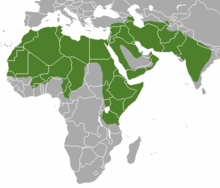| Striped hyena Temporal range: Middle Pleistocene – Recent
| |
|---|---|

| |
| Scientific classification | |
| Domain: | Eukaryota |
| Kingdom: | Animalia |
| Phylum: | Chordata |
| Class: | Mammalia |
| Order: | Carnivora |
| Suborder: | Feliformia |
| Family: | Hyaenidae |
| Subfamily: | Hyaeninae |
| Genus: | Hyaena Brisson, 1762 |
| Species: | H. hyaena
|
| Binomial name | |
| Hyaena hyaena | |

| |
Striped hyena range
| |
| Synonyms[3] | |
|
List
| |
The striped hyena (Hyaena hyaena) is a species of hyena native to North and East Africa, the Middle East, the Caucasus, Central Asia, and the Indian subcontinent. It is the only extant species in the genus Hyaena. It is listed by the IUCN as near-threatened, as the global population is estimated to be under 10,000 mature individuals which continues to experience deliberate and incidental persecution along with a decrease in its prey base such that it may come close to meeting a continuing decline of 10% over the next three generations.[1]
It is the smallest of the bone-cracking hyenas and retains many primitive viverrid-like characteristics lost in larger species,[4] having a smaller and less specialised skull.[5][6] Though primarily a scavenger, large specimens have been known to kill their own prey,[7] and attacks on humans have occurred in rare instances.[8] The striped hyena is a monogamous animal, with both males and females assisting one another in raising their cubs.[9] A nocturnal animal, the striped hyena typically only emerges in complete darkness, and is quick to return to its lair before sunrise.[10] Although it has a habit of feigning death when attacked, it has been known to stand its ground against larger predators in disputes over food.[11]
The striped hyena features prominently in Middle Eastern and Asian folklore. In some areas, its body parts are considered magical, and are used as charms or talismans.[12] It is mentioned in the Hebrew Bible, where it is referred to as tzebua or zevoa, though it is absent in some Bible translations into English.[13] Ancient Greeks knew it as γλάνος (glános) and ύαινα (húaina) and were familiar with it from the Aegean coast of Asia Minor.[14] The striped hyena is the national animal of Lebanon.[15]
- ^ a b AbiSaid, M.; Dloniak, S.M.D. (2015). "Hyaena hyaena". IUCN Red List of Threatened Species. 2015: e.T10274A45195080. doi:10.2305/IUCN.UK.2015-2.RLTS.T10274A45195080.en. Retrieved 19 November 2021.
- ^ Linnæus, C. (1758). Systema naturæ per regna tria naturæ, secundum classes, ordines, genera, species, cum characteribus, differentiis, synonymis, locis. Tomus I (in Latin) (Tenth ed.). Holmiæ (Stockholm): Laurentius Salvius. p. 40. Archived from the original on 2012-11-08. Retrieved 2018-01-14.
- ^ Wilson, D. E.; Reeder, D. M., eds. (2005). "Hyaena hyaena". Mammal Species of the World: A Taxonomic and Geographic Reference (3rd ed.). Johns Hopkins University Press. ISBN 978-0-8018-8221-0. OCLC 62265494.
- ^ Cite error: The named reference
k66was invoked but never defined (see the help page). - ^ Cite error: The named reference
r348was invoked but never defined (see the help page). - ^ Cite error: The named reference
h16was invoked but never defined (see the help page). - ^ Cite error: The named reference
m22was invoked but never defined (see the help page). - ^ Cite error: The named reference
h46was invoked but never defined (see the help page). - ^ Cite error: The named reference
h40was invoked but never defined (see the help page). - ^ Cite error: The named reference
h36was invoked but never defined (see the help page). - ^ Cite error: The named reference
p72was invoked but never defined (see the help page). - ^ Cite error: The named reference
magicwas invoked but never defined (see the help page). - ^ Cite error: The named reference
BOTFwas invoked but never defined (see the help page). - ^ Αριστοτέλης 4th century BCE: Των περί τα ζώα ιστοριών.
- ^ "What is the National Animal of Lebanon?". WorldAtlas. 20 August 2018. Archived from the original on 2020-03-18. Retrieved 2020-03-18.
